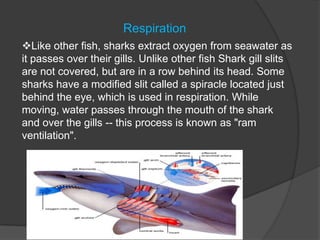This document provides information about sharks, including their skeleton, respiration system, characteristics, attacks on humans, and the practice of shark fin soup. It notes that sharks have a cartilaginous skeleton that is lighter than bone, helping them move efficiently in water. They breathe by taking in water over their gills. While most shark attacks are exploratory, some species are more likely to attack in warm, shallow waters near groups of people. The demand for shark fin soup has led to overfishing and finning, where sharks have their fins cut off while still alive.






















